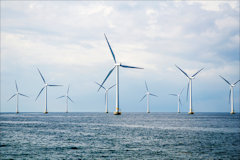by James A. Bacon
Governor Ralph Northam has issued an executive order outlining how Virginia can reach the goals of producing 30% of its electricity from renewable energy sources by 2030 and 100% from carbon-free sources by 2050. The governor’s vision relies heavily upon solar power, offshore wind, and energy storage, while emphasizing “energy equity” for “communities of color” and lower-income Virginians.
Northam’s plan relies heavily upon Virginia’s investor-owned utilities, Dominion Energy and Appalachian Power Co., to make investments in solar, wind, and energy-storage, and contemplates no significant changes to the existing electric-utility framework. The plan also has won the blessing of at least one of Virginia’s leading environmental groups.
“Governor Northam’s announcement today shows real leadership on climate change in the face of its absence at the federal level,” said Will Cleveland, a senior attorney with the Southern Environmental Law Center in a prepared statement. “It’s time for this kind of cost effective, smart and modern solution to bring Virginia into the future.”
Virginia currently has a statewide goal of achieving 5,500 megawatts of wind and solar energy by 2028, at least 3,000 megawatts of which should be under development by 2022. In furtherance of this goal, states the governor’s order, Dominion has committed to build up to 500 megawatts annually of utility-scale solar and onshore wind through a competitive procurement process, and to implement a process for procuring smaller-scale energy, including rooftop solar. Apco has instituted a procurement process for 200 megawatts of utility-scale solar
The governor’s plan also envisions reducing retail electricity consumption by 20% by 2022 (using 2006 as a baseline) by means of tighter building codes, energy performance contracting, private financing, $870 million in investment by Dominion in energy-efficiency programs, and $140 million in Apco energy-efficiency programs.
Northam also wants to move full steam ahead on offshore wind. A 12 megawatt demonstration project currently under construction is expected to lead to a larger offshore project of 2,500 megawatts that could be fully developed by 2026.
Solar and wind are intermittent energy sources, and provisions must be made to supply electricity when the sun and wind aren’t cooperating. Dominion is developing a 30 megawatt battery-storage pilot program, and Apco is investing in a 10-megawatt project. Further, notes the order, “pumped hydroelectric storage facilities are now deemed in the public interest.”
The plan also addresses issues “related to equity and environmental justice.” Clean energy resources, states the order, “shall be deployed to maximize the economic and environmental benefit to underserved communities while mitigating any impacts to those communities.”
The Commonwealth will play a major role in advancing the governor’s goals by procuring “at least 30 percent of the electricity under the statewide electric contract with Dominion Energy from renewable energy resources by 2022,” and investing extensively in energy efficiency.
Issues not addressed: The governor’s order makes no mention of nuclear power. All four of Dominion’s nuclear units are up for license renewal within the time-frame covered by the plan. Dominion wants to keep the aging plants in place to provide a zero-carbon base-load capacity. Many environmentalists oppose renewal of the licenses.
The order also avoids any mention of natural gas, the Atlantic Coast Pipeline, and the Mountain Valley Pipeline. Dominion regards natural gas as the logical back-up for intermittent solar and wind for the foreseeable future, but environmentalists say it makes no sense to make long-term commitments to natural gas infrastructure when new battery-storage technologies are being developed that might make gas obsolete.
In his statement, the SELC’s Cleveland said that a zero-carbon future will “ensure efficient, in-state, low-cost electricity.” Virginia is second only to California as an importer of electricity from outside the state, and a gas/wind/storage portfolio arguably support more jobs and tax base in the state.
On the other hand, it is harder to support the claim that Virginians will enjoy lower electric rates if it means accelerating the phase-out of coal-fired plants, shuttering gas-fired plants, building offshore wind in the absence of a maritime infrastructure to support it, and constructing a pumped-storage facility in the mountains of Southwestern Virginia. Further, while advances in battery-storage technology look promising, there are no guarantees that batteries will slide down the same lower-cost curve as solar and wind. Expect all of those claims to be subjected to close scrutiny as the debate over energy policy unfolds.




